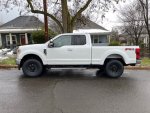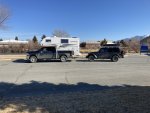mk216v
Der Chef der Fahrzeuge
Thanks for the info above, all.
Also, MANY thanks to @klahanie for reminding me where the tire inflation "matrix" tables were located on the web. They can be found here;

 www.toyotires.com
www.toyotires.com
Interesting to see, starting on pg23, what the load ratings are as tire pressure reduces.
Let's use @montypower (Peter's) setup as an example. He runs;
37x12.5x17 Yokohama Geolandar X-AT, D load.
Front 20-25psi and rear 30-35psi.
Front: 4,650lbs(~2325lbs/ea corner) and Rear: 6,150lbs(~3075lbs/ea corner)
Looking at the table at the very end of pg31 of the Toyo pdf, under 37x12.5x17 D load;
For front; weight spec at 20psi has no weight data, weight spec at 25psi is 2150lbs/ea corner.
For rear; weight spec at 30psi is 2470lbs/ea corner, weight spec at 35psi is 2755lbs/corner.
So, at Xpsi front or rear, Peter has been loading about 10% add'l weight onto each corner of his tires, beyond what Toyo suggests for Xpsi. And his tires have held up. Not saying that's always going to be the case, but it is here on this truck with the Yoko tires.
What is interesting, is if we look at the table for 37x13.5x17 E load, on pg32, here's the data from it;
For front; weight spec at 20psi has no weight data, weight spec at 25psi is 2205lbs/ea corner (55lbs MORE than 37x12.5x17 D load).
For rear; weight spec at 30psi is 2550lbs/ea corner (80lbs MORE than 37x12.5x17 D load), weight spec at 35psi is 2835lbs/corner (80lbs MORE than 37x12.5x17 D load).
My takeaway is that at lower pressures(40psi or less), there's not a whole lot of difference between 37x12.5x17 D load and 37x13.5x17 E load. And more importantly, a 17" E load tire wouldn't even support Peter's front or rear corner weights.
Now, if we look at 37x13.5x18, while there are many A/T tires available in E load in this size, the table doesn't list E load info, only typical D load (3525lbs max at 50psi max). I'm waiting to hear from a tire industry member to see if there's updated data for 37x13.5x18 E load (No info yet, but @klahanie sent this other load table; https://tirepressure.org/flotation-tire-load-inflation-chart which has 37x13.5x18 data).
But for now, there's data for 37x12.5x18 E load;
For front; weight spec at 20psi has no weight data, weight spec at 25psi is 2095lbs/ea corner (55lbs LESS than the 37x12.5x17 D load, and 110lbs LESS than 37x13.5x17 E load).
For rear; weight spec at 30psi is 2395lbs/ea corner (75lbs LESS than 37x12.5x17 D load, and 155lbs LESS than 37x13.5x17 E load), weight spec at 35psi is 2680lbs/corner (75lbs LESS than 37x12.5x17 D load, and 155lbs LESS than 37x13.5x17 E load).
So, what's the advantage to the 18" wheel? NOTHING I see in regards to Peter's weights, as the 37x12.5x17 D load and 37x12.5x18 E load are pretty even overall up to 40psi (with the 37x12.5x17 D load actually supporting more weight), then the 37x12.5x18 E load takes off at 55psi and begins to hold more weight (3590lbs at 55psi, then 3795lbs at 60psi, then 3970lbs at 65psi). Again, the issue I have with the 37x12.5x18 tire size is that there are only a few A/T tread patterns.
Interesting that the 371x12.5x17 D load has the same data as the 37x13.5x18 D load.
Of course if you have over 3500lbs/ea corner (55+psi), then the 37x12.5x18 E load is suggested. But if you have less weight than that, then there's no advantage I see to the 37x12.5x18 E load over the 37x12.5x17 D load. In fact, one could argue that if you do a lot of offroad low-psi driving, the 37x12.5x17 D load supports more weight than the 37x12.5x18 E load at 40psi or lower. And then the 37x13.5x17 D/E load supports even more weight than either of them at 35psi or lower.
Here's an easier view;
37x12.5x17 D/124 (there is a 37x12.5x17 F load in the table too, but it's data looks to be the same as the E load; 3195lbs/F/121 from 50-80psi);
25____30___35___________40____45___50psi
2150_2470_2755(C/116)_3005_3250_3525(D/124)lbs
37x13.5x17 (D/121 or E/121);
25____30___35____40___45____50___________55____60___65psi
2205_2550_2835_2955_3075_3195(D/121)_3195_3195_3195(E/121)lbs
37x12.5x18 E/128;
25____30___35___________40___45____50____________55___60____65psi
2095_2395_2680(C/115)_2915_3150_3415(D/123)_3590_3795_3970(E/128)lbs
37x13.5x18 D/124;
25____30___35____40____45___50psi
2150_2470_2755_3005_3250_3525(D/124)lbs
37x13.5x18 E/128?;
25____30___35____________40___45____50_____________55___60____65psi
2150_2470_2755(C/116?)_3005_3250_3525(D/124?)_3675_3820_3970(E/128)lbs
Since I want to focus on 12.5"W for myself, and the 37x13.5x18 is worst case for me, let's compare these 3 only;
37x12.5x17 D/124;
25____30___35___________40____45___50psi
2150_2470_2755(C/116)_3005_3250_3525(D/124)lbs
37x12.5x18 E/128;
25____30___35___________40___45____50____________55___60____65psi
2095_2395_2680(C/115)_2915_3150_3415(D/123)_3590_3795_3970(E/128)lbs
37x13.5x18 E/128?;
25____30___35____________40___45____50_____________55___60____65psi
2150_2470_2755(C/116?)_3005_3250_3525(D/124?)_3675_3820_3970(E/128?)lbs
IF the 37x13.5x18 data in the 2nd URL is true, then both the 37x12.5x17 D/124 and 37x13.5x18 E/128 allow more load than the 37x12.5x18 E/128.
As well, the 37x12.5x17 D/124 and 37x13.5x18 E/128 offer the same load capacity up to 50psi.
ONLY after 50psi does the 37x13.5x18 E/128 offer more than 3525/lbs per tire capacity; 3675lbs at 55psi, 3820lbs at 60psi, and 3970lbs at 65psi.
So if my actual corner weight is less than ~3000lbs (so I have ~15% buffer room), then either the 37x12.5x17 D/124 and 37x13.5x18 E/128 should work well for my use case.
Also, MANY thanks to @klahanie for reminding me where the tire inflation "matrix" tables were located on the web. They can be found here;

Find the Correct Tire Inflation Pressure
These Load and Inflation Tables are intended to provide assistance when replacing tires with optional tire sizes including “plus sizes.”
Interesting to see, starting on pg23, what the load ratings are as tire pressure reduces.
Let's use @montypower (Peter's) setup as an example. He runs;
37x12.5x17 Yokohama Geolandar X-AT, D load.
Front 20-25psi and rear 30-35psi.
Front: 4,650lbs(~2325lbs/ea corner) and Rear: 6,150lbs(~3075lbs/ea corner)
Looking at the table at the very end of pg31 of the Toyo pdf, under 37x12.5x17 D load;
For front; weight spec at 20psi has no weight data, weight spec at 25psi is 2150lbs/ea corner.
For rear; weight spec at 30psi is 2470lbs/ea corner, weight spec at 35psi is 2755lbs/corner.
So, at Xpsi front or rear, Peter has been loading about 10% add'l weight onto each corner of his tires, beyond what Toyo suggests for Xpsi. And his tires have held up. Not saying that's always going to be the case, but it is here on this truck with the Yoko tires.
What is interesting, is if we look at the table for 37x13.5x17 E load, on pg32, here's the data from it;
For front; weight spec at 20psi has no weight data, weight spec at 25psi is 2205lbs/ea corner (55lbs MORE than 37x12.5x17 D load).
For rear; weight spec at 30psi is 2550lbs/ea corner (80lbs MORE than 37x12.5x17 D load), weight spec at 35psi is 2835lbs/corner (80lbs MORE than 37x12.5x17 D load).
My takeaway is that at lower pressures(40psi or less), there's not a whole lot of difference between 37x12.5x17 D load and 37x13.5x17 E load. And more importantly, a 17" E load tire wouldn't even support Peter's front or rear corner weights.
Now, if we look at 37x13.5x18, while there are many A/T tires available in E load in this size, the table doesn't list E load info, only typical D load (3525lbs max at 50psi max). I'm waiting to hear from a tire industry member to see if there's updated data for 37x13.5x18 E load (No info yet, but @klahanie sent this other load table; https://tirepressure.org/flotation-tire-load-inflation-chart which has 37x13.5x18 data).
But for now, there's data for 37x12.5x18 E load;
For front; weight spec at 20psi has no weight data, weight spec at 25psi is 2095lbs/ea corner (55lbs LESS than the 37x12.5x17 D load, and 110lbs LESS than 37x13.5x17 E load).
For rear; weight spec at 30psi is 2395lbs/ea corner (75lbs LESS than 37x12.5x17 D load, and 155lbs LESS than 37x13.5x17 E load), weight spec at 35psi is 2680lbs/corner (75lbs LESS than 37x12.5x17 D load, and 155lbs LESS than 37x13.5x17 E load).
So, what's the advantage to the 18" wheel? NOTHING I see in regards to Peter's weights, as the 37x12.5x17 D load and 37x12.5x18 E load are pretty even overall up to 40psi (with the 37x12.5x17 D load actually supporting more weight), then the 37x12.5x18 E load takes off at 55psi and begins to hold more weight (3590lbs at 55psi, then 3795lbs at 60psi, then 3970lbs at 65psi). Again, the issue I have with the 37x12.5x18 tire size is that there are only a few A/T tread patterns.
Interesting that the 371x12.5x17 D load has the same data as the 37x13.5x18 D load.
Of course if you have over 3500lbs/ea corner (55+psi), then the 37x12.5x18 E load is suggested. But if you have less weight than that, then there's no advantage I see to the 37x12.5x18 E load over the 37x12.5x17 D load. In fact, one could argue that if you do a lot of offroad low-psi driving, the 37x12.5x17 D load supports more weight than the 37x12.5x18 E load at 40psi or lower. And then the 37x13.5x17 D/E load supports even more weight than either of them at 35psi or lower.
Here's an easier view;
37x12.5x17 D/124 (there is a 37x12.5x17 F load in the table too, but it's data looks to be the same as the E load; 3195lbs/F/121 from 50-80psi);
25____30___35___________40____45___50psi
2150_2470_2755(C/116)_3005_3250_3525(D/124)lbs
37x13.5x17 (D/121 or E/121);
25____30___35____40___45____50___________55____60___65psi
2205_2550_2835_2955_3075_3195(D/121)_3195_3195_3195(E/121)lbs
37x12.5x18 E/128;
25____30___35___________40___45____50____________55___60____65psi
2095_2395_2680(C/115)_2915_3150_3415(D/123)_3590_3795_3970(E/128)lbs
37x13.5x18 D/124;
25____30___35____40____45___50psi
2150_2470_2755_3005_3250_3525(D/124)lbs
37x13.5x18 E/128?;
25____30___35____________40___45____50_____________55___60____65psi
2150_2470_2755(C/116?)_3005_3250_3525(D/124?)_3675_3820_3970(E/128)lbs
Since I want to focus on 12.5"W for myself, and the 37x13.5x18 is worst case for me, let's compare these 3 only;
37x12.5x17 D/124;
25____30___35___________40____45___50psi
2150_2470_2755(C/116)_3005_3250_3525(D/124)lbs
37x12.5x18 E/128;
25____30___35___________40___45____50____________55___60____65psi
2095_2395_2680(C/115)_2915_3150_3415(D/123)_3590_3795_3970(E/128)lbs
37x13.5x18 E/128?;
25____30___35____________40___45____50_____________55___60____65psi
2150_2470_2755(C/116?)_3005_3250_3525(D/124?)_3675_3820_3970(E/128?)lbs
IF the 37x13.5x18 data in the 2nd URL is true, then both the 37x12.5x17 D/124 and 37x13.5x18 E/128 allow more load than the 37x12.5x18 E/128.
As well, the 37x12.5x17 D/124 and 37x13.5x18 E/128 offer the same load capacity up to 50psi.
ONLY after 50psi does the 37x13.5x18 E/128 offer more than 3525/lbs per tire capacity; 3675lbs at 55psi, 3820lbs at 60psi, and 3970lbs at 65psi.
So if my actual corner weight is less than ~3000lbs (so I have ~15% buffer room), then either the 37x12.5x17 D/124 and 37x13.5x18 E/128 should work well for my use case.
Last edited:


